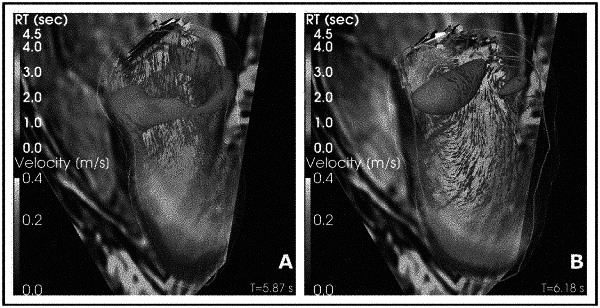| CPC A61B 5/7275 (2013.01) [A61B 5/0044 (2013.01); A61B 5/029 (2013.01); A61B 5/02028 (2013.01); A61B 5/0263 (2013.01); A61B 5/0285 (2013.01); A61B 5/743 (2013.01); A61B 6/507 (2013.01); A61B 6/5205 (2013.01); A61B 6/5223 (2013.01); A61B 8/0883 (2013.01); A61B 8/5223 (2013.01); G16H 30/40 (2018.01); G16H 50/30 (2018.01); A61B 5/055 (2013.01); A61B 8/06 (2013.01); A61B 8/488 (2013.01); A61B 8/5207 (2013.01); A61B 2576/023 (2013.01)] | 21 Claims |

|
1. A method for identifying regions of blood flow stasis inside a cardiac chamber or a blood vessel of a subject comprising:
obtaining flow-velocity images of blood inside the cardiac chamber or the blood vessel of the subject;
calculating one or more of residence time (TR), standard deviation of residence time (σR), kinetic energy, or rate of distortion of blood particles inside the cardiac chamber or the blood vessel using the flow-velocity images to generate numerical metrics of blood flow; and
generating one or more maps comprising a residence time (TR) map, a kinetic energy map, a rate of distortion map, or combinations thereof, using the numerical metrics to identify and characterize the regions of blood flow stasis, wherein identifying and characterizing the regions of blood flow stasis comprises:
identifying one or more regions of blood flow stasis from the generated maps, wherein each region of blood flow stasis has blood flow residence time greater than a threshold value; and
for each region of blood flow stasis:
generating a time-varying blood residence time feature for the region of blood flow stasis, comprising, for each of multiple time points within a cardiac cycle, spatially averaging blood residence time over the region of blood flow stasis at the time point; and
temporally averaging the time-varying blood residence time feature for the region of blood flow stasis to generate a temporally-averaged blood residence time feature for the region of blood flow stasis.
|